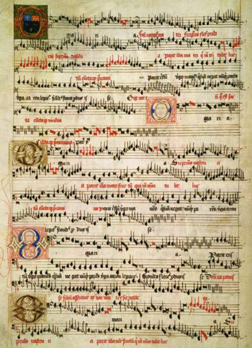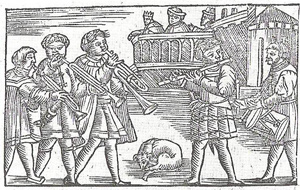Lesson 2: The Effects of Music in Society
Lesson 2: The Effects of Music in Society

Lesson 2: The Effects of Music in Society
The Effects of Music in Society
One important development of the Renaissance period was the invention and use of the printing press. You may be wondering how the printing press relates to music, but it had a tremendous effect on the evolution of music and how we experience it today. The printing press created the ability for individuals and companies to produce copies of music. Rather than having to copy the musical notation by hand, individuals could now produce multiple copies of music more easily. This allowed music to spread throughout a society and into others faster and more efficiently.
Eton Choirbook
The printing press also initiated the printing of music for commercial purposes. This largely began in Venice, Italy, around 1501, when Ottaviano Petrucci printed the first significant collection of polyphonic music. Other commercial operations soon sprung up around Europe. Printers were able to produce large quantities of the music, including printing runs of between 500 and 2000 copies. The ability to print these quantities occurred at the same time that a larger middle and upper class were spending more time in leisure activities, including playing music for themselves. Printers also produced religious music, which was bought by parishes and other religious institutions in addition to individuals. The commercial printing of music benefited not only printers, but also the composers of music, who were now able to gain greater profits from their works.
As mentioned above, music came to occupy a greater position in society during the Renaissance period. One reason for this was the growing number of people who had more time for leisure activities. This increased not only the time that people had to listen to music, but also the time that they could invest in learning to play instruments and music. This helped to develop music as a form of entertainment and leisure, apart from religious or ritualistic uses. While music probably provided a great deal of enjoyment in earlier periods, the Renaissance helped to develop the private, personal relationships to music in terms of playing for fun within the home that we see today in our relationship to music.
As leisure time grew, so too did the popularity of dancing to music. While dancing was nothing new, many Renaissance individuals enjoyed dancing, and it was an important part of many social events. In fact, the educated and upper classes in society were expected to know how to dance for social functions. The dances common during this period varied widely, from slow dances to the beginnings of the ballet. Some of the dances were highly choreographed and took time and practice to learn, such as with the court dances. Since dancing became so popular among so many people, it is not surprising that the music of the time reflected this. Songs were written especially for dancing. Composers tried new instrumental combinations and new patterns in the music in the hope that these would create songs that would be popular dance pieces.
Pipere
Another change in the role of music was the combining of music with written texts. By the late fifteenth century, music was being added to the performance of poetry and other written texts to add to and heighten the meaning of the written words. This was not a new use of music, as the ancient Greeks had also used the combination of written texts and music. The Greeks studied music as an artistic form as well as through science and philosophy. Renaissance musicians and writers expanded on this and found new ways to encourage the connections. Sir Thomas More, who published Utopia in 1516, argued that music could help express and clarify the 'inner meanings' of texts. This change occurred not only with secular texts, but also with sacred, religious texts and information. In addition, there was a resurgence of the belief that music could change a person's actions, attitudes, and moods.
While the Catholic Church influenced much of the music during the Middle Ages, the Church's influence was lessened during the Renaissance. This is not to say that it had no influence, because that was not the case. The Church continued to influence music and composers continued to write music for use within religious institutions. However, it is true that more people began to look outside of the Catholic Church for inspiration and answers to life's questions. Some of this still included religion, as the Protestant Reformation in 1517 created another outlet for religious music. Some composers also embraced inspiration in the secular world, producing music for purposes outside of religion or religious institutions.